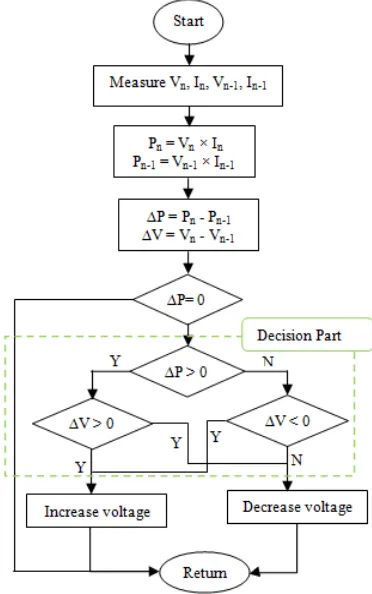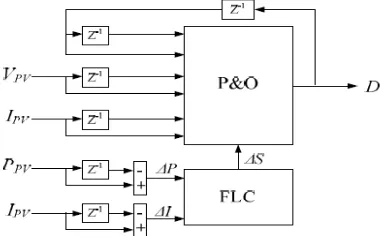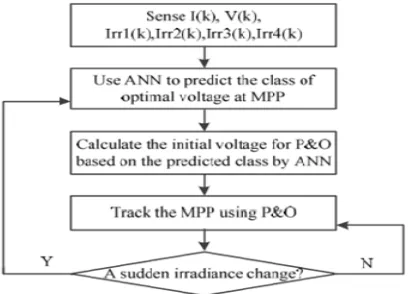DOI: 10.12928/TELKOMNIKA.v13i3.1439 745
A Review on Perturb and Observe Maximum Power
Point Tracking in Photovoltaic System
Rozana Alik*1, Awang Jusoh2,Tole Sutikno3 1,2
Department of Electrical Power, Faculty of Electrical Engineering, Universiti Teknologi Malaysia UTM Skudai, 81310 Johor Bahru, Johor, Malaysia
3
Department of Electrical Engineering, Faculty of Industrial Technology, Universitas Ahmad Dahlan Janturan, Yogyakarta 55164, Indonesia
*Corresponding author, email: [email protected], [email protected], [email protected]
Abstract
Solar energy is becoming popular and has drawn lots of attention from researchers nowadays. However, the output power of the photovoltaic (PV) arrays varies with solar irradiation and temperature, which affect the efficiency of PV arrays. Therefore, Maximum Power Point Tracking (MPPT) control technique is used to extract the maximum available power from the PV arrays. Perturb and Observe (P&O) algorithm is one of the favorite techniques frequently used due to its simplicity and low cost. Yet, the conventional P&O algorithm has several drawbacks, which leads to power loss and lack of efficiency. This paper presents comparison of the basic P&O algorithm with the modified P&O algorithm used for partial shading condition in terms of complexity, accuracy, cost, and basic concept of each method.
Keywords: maximum power point tracking, Perturb and Observe algorithm, partial shading, solar photovoltaic
Copyright © 2015 Universitas Ahmad Dahlan. All rights reserved.
1. Introduction
Fulfilling the energy demand from the people all over the world would be not enough if the energy sources are only limited to utilization of non-renewable sources such as fuel, gas and coal. Besides, most non-renewable energies cause pollution and less non-environmentally friendly. Hence, renewable energies are introduced in the past two decades to fulfill the energy demand. One of the popular renewable energies is solar energy which is extracted by converting sunlight into electrical power using the photovoltaic system. However, the conversion efficiency is relatively low with the range of only from 12% up to 20%, and it is highly dependent on the solar irradiation and panel temperature [1]. Thus, in this paper, Maximum Power Point Tracking (MPPT) control technique is explained which can increase the efficiency of the overall Photovoltaic (PV) system by extracting the maximum available power from the PV arrays [1-3].
There are many MPPT techniques that have been introduced and elaborated extensively by researchers. Reference [4] stated that at least 19 distinct methods have been promoted, developed and implemented to improve solar photovoltaic. Each method differs in theirs complexity, number of sensors used, cost and effectiveness.
A number of soft computing based MPPT methods also have been proposed, such as Fuzzy Logic Control (FLC) [10, 11] and Artificial Neural Network (ANN) [12]. The advantages of using FLC method are it does not require accurate mathematical model and can operate well under varying atmospheric conditions. Yet, the effectiveness of this method depends a lot on the user knowledge. Even though MPPT with ANN controller can provide good performance, the neural network must be trained specifically beforehand with the PV array [4, 13].
Despite of the availability of other MPPT techniques, Perturb and Observe (P&O) algorithm is still the most common and broadly used due to its simplicity and low cost implementation [1], [3-4], [13-18]. Besides, it can be used practically in microcontroller or Digital Signal Processing System. Nevertheless, the conventional P&O algorithm still have several drawbacks. Therefore, the next section of this paper will describe more on the P&O algorithm and the modification made by researchers to improve the algorithm, especially during the partial shading condition.
2. Perturb and Observe (P&O) MPPT 2.1. Conventional P&O MPPT
The basic concept of Perturb and Observe (P&O) algorithm involves the perturbation of solar PV operation point corresponding to the sign of the last increment of PV power [16, 18]. In this method, any changes of perturb voltage ∆V are commanded by the algorithm to the PV module operating voltage. P&O will determine whether the operating voltage should be increased or decreased by ∆V after the process of observing output power has taken place [19].
Figure 1 shows more detail on the operation of the conventional P&O algorithm. Based on the obtained information, P&O algorithm is able to predict when the operating voltage is approaching the VMPP by comparing the actual and the previous state of the power, P, and voltage, V. In short, the next perturbation to reach the MPP will be the same if there is an increment of P and vice versa [20], as shown concluded in Table 1.
Table 1. Summary of P&O Algorithm
Perturbation ∆P Next Perturbation
Positive Positive Positive
Positive Negative Negative
Negative Positive Negative
Negative Negative Positive
The process of perturbation and observation will be carried continuously until the systems reach the MPP. Reference [21] stated that the two important parameters for this algorithm are the perturbation step size and the time between algorithm iteration. Somehow, large perturbation step size is needed to speed up the response, but it will contribute to the loss of power due to the imprecise tracking. As the step size is reduced, the MPP tracking system will slow down the response. Consequently, time taken to complete the algorithm becomes longer.
Many studies had been done to modify the algorithm so that the tracking speed and algorithm accuracy can be improved. Many researchers have proposed variable step size concept since P&O MPPT with fixed step size does not provide a good tradeoff.
2.2. Modified P&O MPPT
Reference [1, 22] used fuzzy logic controller (FLC) to vary the step size, as presented in Figure 2. FLC functions to determine the suitable step size to be used in the algorithm.
For the simulation purpose, a Buck DC-DC converter with Pulse Width Modulation (PWM) controller was also included in the PV system. As a result, the modified P&O was able to improve both the steady state and dynamic performance of the system.
Figure 2. Modified P&O Algorithm with FLC Figure 3. Modification of P&O Algorithm
The step size also could be varied by modifying the decision part of the flowchart (Figure 1) as being proposed by [7]. As shown in Figure 3, whenever the perturbation moved away from the MPP i.e ∆P < 0, the duty cycle was reduced by dividing the voltage with A and vice versa, where A is a constant larger than 1. The improved P&O had successfully combined the speed of relatively large step size and the smooth tracking of the small step size of P&O.
There are some researchers who combined other method with the variable step size of P&O algorithm to produce better performance of MPPT, as done by [8]. The technique used for MPPT in that paper was a combination between variable step size perturbation and constant voltage tracking. Basically, when the light intensity changed drastically, the constant voltage method would take place, and when the change of light intensity tended to be stable, then P&O should be preferable. The results obtained from the Simulink simulation proved that this method can promptly achieve MPP without any misjudgments of different light intensity and temperature condition.
2.3. Modification of P&O MPPT
The common drawback of conventional P&O MPPT, which is the step size problem, can literally be solved by modifying the algorithm. Most of modified P&O MPPT are shown able to
N Y
∆P > 0
Vn×A Vn÷A
produce better performance compared to the conventional MPPT. Table 2 shows the comparison between three modified P&O MPPT in terms of complexity, accuracy and cost.
According to Table 2, modification made by [7] is the best idea since it does not require any additional electronic components and is simpler than other methods. Apart from the step size issue, P&O MPPT is also unable to produce high efficiency when the irradiation is not constant. The next section will explain more modification made on the algorithm to overcome the shading issue.
Table 2. Comparison between Modified P&O Algorithms Modified MPPT
Characteristic
P&O with Fuzzy Logic Controller
P&O with constant A P&O with constant voltage tracking
Complexity Complex Simple Medium
Accuracy Good Good Good
Cost High Low Low
3. P&O MPPT for Partial Shading Condition
3.1. Overview on P&O MPPT under Partial Shading Condition
The sun irradiation would most probably become non-uniform when there is partial shading. In fact, the PV array rarely receives uniform irradiation most of the time, as parts of the PV arrays may be shaded by heavy cloud, trees or nearby buildings, which cause partial shading condition (PSC) [6, 11], [13-14], [19], 23-27].
The MPP can be easily tracked when the solar irradiance is constant, as shown in Figure 4. The tracking process is started at the present value of P&O MPPT, which is zero. The voltage will keep on increasing based on the increment of perturbed voltage. The PV power also will increase until it reaches the MPP. Then, further increment of array operating voltage will lead the PV power to decrease.
The same tracking process does not occur when the PV array experiences PSC. As seen in Figure 5, the P-V characteristic was observed to have multiple local MPP due to the three distinct solar irradiance levels. The P-V characteristic happened to be nonlinear and complex.
Figure 4. Normal P-V characteristic under constant irradiation
Figure 5. P-V characteristic under partial shading condition
2.3 Modified P&O for Partial Shading Condition
For this reason, researchers all over the world attempt to modify the algorithm so that it can work effectively under any irradiation level. Koutroulis, E and Blaabjerg, F [6] proposed a new idea based on controlling a DC-DC converter connected at the PV array output, as shown in Figure 6.
Figure 6. Proposed method with additional global MPPT process
The converter acts as a constant input-power load. The experimental results showed that under any partial shading condition, the algorithm was still able to track the global MPP. In addition, the time taken for the tracking process was much shorter with significantly less PV array power perturbation steps. The main advantage for this method is that it can be applied in PV arrays without requiring knowledge on the PV modules configuration within the PV.
Meanwhile, reference [13] recommended a simple and efficient hybrid MPPT algorithm for PV systems. Figure 7 shows brief description about the proposed method. Basically, the idea is to identify the classification of the suitable operating voltage corresponding to the irradiance level by using ANN. Next, P&O algorithm will be used to track the MPP within the local area based on the classification. In general, this method combines the advantages of P&O and ANN MPPT. Based on the simulation and experimental results, this hybrid MPPT has relatively lower cost, faster response, and much simple structure compared to the conventional technique.
An innovative checking method for P&O algorithm was suggested by [14] to solve the partial shading issue. It is a simple, fast and reliable technique, as presented in the Figure 8.
Figure 8. P&O algorithm with the checking algorithm
Principally, the checking algorithm is used to verify if the algorithm already achieves a real MPP or only a local MPP. Moreover, this algorithm does not require any additional electronic components and it can find the true MPP under any operating conditions.
3.3. Comparison on Modified P&O MPPT for Partial Shading Condition
In a nutshell, all of the modified P&O MPPT are able to achieve the true MPP. Table 3 depicts the comparison between the three methods that have been elaborated in the previous section. The proposed method with the checking algorithm is absolutely the best since it has lower cost and is the simplest than the other methods.
Table 3. Comparison between Modified P&O Algorithms for PSC Modified MPPT
Characteristic
P&O with DC-DC Converter as a constant input-power
load
P&O with ANN P&O with innovative checking algorithm
Complexity Complex Medium Simple
Accuracy Good Good Good Cost High Low Low
4. Conclusion
In short, P&O MPPT Algorithm is the most efficient MPPT for photovoltaic system due to its characteristics of being simple and low cost implementation. Still, the step size problem and partial shading issue affect the accuracy of the algorithm to achieve true MPP, as well as contribution for the power losses. Thus, some modifications must be made in order to improve the performance of P&O MPPT. This paper has reviewed and compared three modified methods for each issue and as a conclusion; the best method is the one that can provide good accuracy, simple and low cost.
Acknowledgements
References
[1] Aashoor F, F Robinson. A variable step size perturb and observe algorithm for photovoltaic maximum power point tracking. In Universities Power Engineering Conference (UPEC), 2012 47th International. 2012.
[2] Ji YH, et al. A real maximum power point tracking method for mismatching compensation in PV array under partially shaded conditions. Power Electronics, IEEE Transactions on, 2011. 2011; 26(4): 1001-1009.
[3] Mohanty P, et al. MATLAB based modeling to study the performance of different MPPT techniques used for solar PV system under various operating conditions. Renewable and Sustainable Energy Reviews. 2014; 38: 581-593.
[4] Esram T, PL Chapman. Comparison of photovoltaic array maximum power point tracking techniques. IEEE TRANSACTIONS ON ENERGY CONVERSION EC. 2007; 22(2): 439.
[5] Eltawil MA, Z Zhao. MPPT techniques for photovoltaic applications. Renewable and Sustainable Energy Reviews. 2013; 25; 793-813.
[6] Koutroulis E, F Blaabjerg. A new technique for tracking the global maximum power point of PV arrays operating under partial shading condition. Photovoltaics, IEEE Journal. 2012; 2(2): 184-190.
[7] Mohammed OJEI. Solar Photovoltaic (PV) Maximum Power Point Tracker (MPPT) using Variable Step Size Perturb and Observe (P&O) Algorithm, In Electrical 2014. 2014: 57.
[8] Zhang K, P Cheng, L He. A Maximum Power Point Tracking Method Combined with Constant Voltage Tracking & Variable Step-Size Perturbation. 2014.
[9] Mastromauro RA, M Liserre, A Dell'Aquila. Control issues in single-stage photovoltaic systems: MPPT, current and voltage control. Industrial Informatics, IEEE Transactions. 2012; 8(2): 241-254.
[10] Algazar MM, et al. Maximum power point tracking using fuzzy logic control.International Journal of Electrical Power & Energy Systems. 2012; 39(1): 21-28.
[11] Chin CS, et al. Optimization of partially shaded PV array using fuzzy MPPT. In Humanities, Science and Engineering (CHUSER), 2011 IEEE Colloquium. 2011.
[12] Rai AK, et al. Simulation model of ANN based maximum power point tracking controller for solar PV system. Solar Energy Materials and Solar Cells. 2011; 95(2): 773-778.
[13] Jiang LL, et al. A simple and efficient hybrid maximum power point tracking method for PV systems under partially shaded condition. In Industrial Electronics Society, IECON 2013-39th Annual Conference of the IEEE. 2013.
[14] Alonso R, et al. An innovative perturb, observe and check algorithm for partially shaded PV systems. In Power Electronics and Applications, 2009. EPE'09. 13th European Conference. 2009.
[15] Alqarni M, MK Darwish. Maximum power point tracking for photovoltaic system: modified perturb and observe algorithm. In Universities Power Engineering Conference (UPEC), 2012 47th International. 2012.
[16] DebBarma M, et al. Maximum Photovoltaic Power Tracking using Perturb & Observe Algorithm in Matlab/Simulink Environment. International Journal of Electrical Engineering & Technology (IJEET). 2010; 1(1): 71-84
[17] Hamidon F, PA Aziz, NM Yunus. Photovoltaic array modelling with P&O MPPT algorithm in MATLAB. In Statistics, Science, Business, and Engineering (ICSSBE), 2012 International Conference. 2012. [18] Jusoh A, et al. A Review on Favourable Maximum Power Point Tracking Systems in Solar Energy
Application. TELKOMNIKA (Telecommunication Computing Electronics and Control). 2014; 12(1): 6-22.
[19] Chin CS, et al. Maximum power point tracking for PV array under partially shaded conditions. In Computational Intelligence, Communication Systems and Networks (CICSyN), 2011 Third International Conference. 2011.
[20] Sridhar R, et al. Performance improvement of a photo voltaic array using MPPT (P&O) technique. In Communication Control and Computing Technologies (ICCCCT), 2010 IEEE International Conference. 2010.
[21] Sokolov M, et al. Dynamic analysis of photovoltaic system with MPP locus emulation. In Electrical and Electronics Engineers in Israel (IEEEI), 2010 IEEE 26th Convention. 2010.
[22] ABDOURRAZIQ S, R EL BACHTIRI. A Perturb and Observe Method using Dual Fuzzy Logic Control for Resistive Load. In practice. 8: 9.
[23] Azharuddin M. Effects of Shading on the Output Power of Photovoltaic Arrays. In Electrical and Computer Engineering. 2012: 122.
[24] Ben Salah C, M Ouali. Comparison of fuzzy logic and neural network in maximum power point tracker for PV systems. Electric Power Systems Research. 2011; 81(1): 43-50.
[25] Sayal A. MPPT techniques for photovoltaic system under uniform insolation and partial shading conditions. In Engineering and Systems (SCES), 2012 Students Conference. 2012.
[26] Fennich M. Tracking the global maximum power point of PV arrays under partial shading conditions. In Electrical and Computer Engineering. 2013: 59.




